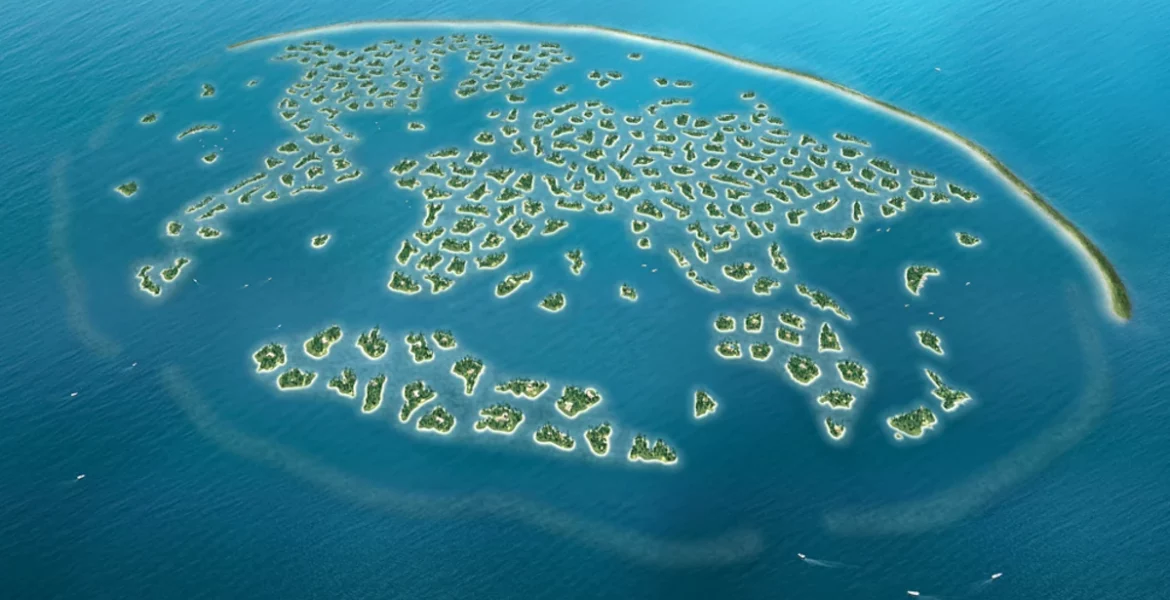Man-made islands have captured the imagination of people for centuries, often seen as a symbol of human ingenuity, ambition, and the relentless drive to reshape nature for personal or economic gain. These islands, which range from luxury getaways to floating cities and commercial hubs, are scattered across the globe and offer a glimpse into the future of urban development, tourism, and sustainability. Let’s take a look at some of the most remarkable man-made islands around the world.
Palm Jumeirah [UAE]

Created in the shape of a palm tree, this artificial island is part of a series of ambitious developments by Nakheel Properties in Dubai, UAE. Palm Jumeirah is home to luxurious hotels, private villas, and upscale shopping centers, with the Atlantis Hotel being one of its most recognizable landmarks. The island was constructed using land reclamation techniques, with millions of tons of sand and rock placed in the Persian Gulf to form its distinctive palm shape. As a symbol of Dubai’s wealth and architectural prowess, Palm Jumeirah has become a major tourist destination and a symbol of the city’s rapid development.
Our Lady of the Rocks [Montenegro]

Nestled in the Bay of Kotor, Montenegro, Our Lady of the Rocks is a picturesque island steeped in history and religious significance. Legend has it that the island was formed by local seamen who, after finding an icon of the Virgin Mary, placed rocks in the bay as a mark of gratitude. Over the centuries, the island was built up with more stones, eventually creating a small sanctuary with a church and a museum. Today, visitors can explore the island’s impressive religious artworks and marvel at its picturesque surroundings. Accessible only by boat, Our Lady of the Rocks stands as a testament to both faith and human persistence.
Île aux Cygnes [France]

Located in the Seine River in Paris, Île aux Cygnes is a small artificial island built in the mid-19th century as part of the river’s bank expansion. Originally intended to protect the riverbank from erosion, the island is now a popular park and promenade, offering panoramic views of Paris. One of its most remarkable features is a replica of the Statue of Liberty, which stands proudly on the island’s western tip. The island provides a peaceful escape from the hustle and bustle of the city and has become a favored spot for locals and tourists alike to enjoy leisurely walks, picnics, and scenic views of the Eiffel Tower.
Islands of the Uros [Peru]

Floating on the serene waters of Lake Titicaca, the Islands of the Uros are a marvel of indigenous engineering. The Uros people have inhabited these islands for centuries, constructing them from totora reeds, which grow abundantly in the lake. These floating islands are held together by layers of reeds, which are continuously replenished to maintain their buoyancy. The Uros people live in traditional reed houses and navigate their islands using reed boats. Visiting these islands offers a rare glimpse into an ancient way of life that has adapted to the ever-changing nature of the environment. It also serves as a fascinating reminder of human resilience and ingenuity in the face of harsh living conditions.
Amwaj Islands [Bahrain]

The Amwaj Islands in Bahrain represent a blend of luxury living and natural beauty. Located off the northeastern coast of Bahrain’s main island, the Amwaj Islands were created through extensive land reclamation and now serve as a high-end residential and commercial development. The islands boast a mix of beachfront properties, five-star hotels, marinas, and recreational facilities, making it a popular destination for both locals and international visitors. These islands symbolize Bahrain’s efforts to create sustainable developments that harmonize with the country’s rapid growth, making them a hub for business and tourism in the Persian Gulf region.
Nigehorn [Germany]

In the northern part of Germany, on the North Sea coast, lies Nigehorn, a fascinating example of land reclamation. Originally an isolated sandbank, Nigehorn was transformed into a man-made island as part of a Dutch-German cooperative project aimed at improving navigation and protecting the coast from rising sea levels. Today, the island is home to various wildlife and serves as a protected natural reserve. With its unspoiled landscapes and tranquil environment, Nigehorn remains a rare instance where human intervention has worked to preserve and protect natural ecosystems.
Kamfers Dam [South Africa]

In the heart of South Africa, the Kamfers Dam is home to one of the most unique man-made islands in the world. This island, located in the Northern Cape province of South Africa, is a sanctuary for thousands of flamingos. Built as part of a bird conservation project, the island is designed to provide a safe haven for these endangered birds to nest. What makes Kamfers Dam especially remarkable is that the island is entirely artificial, constructed by placing large amounts of sand and rock in the dam to create a stable platform for the flamingos. Today, the island serves as a critical ecological habitat, supporting the protection and preservation of local wildlife.
[Contributed By Anushka Gaikwad]











